Bill Gates
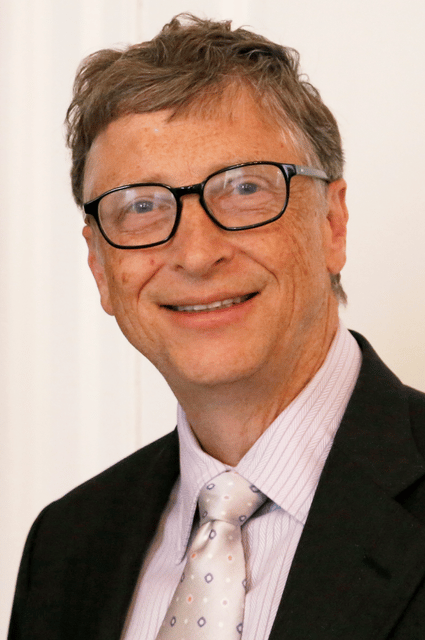
Bill Gates

Bill Gates KBE | |
|---|---|
| Born | William Henry Gates III (1955-10-28)October 28, 1955 Seattle, Washington, U.S. |
| Residence | "Xanadu 2.0", Medina, Washington |
| Occupation |
|
| Known for | Principal founder of Microsoft |
| Net worth | US$103.7 billion(August 2019)[3] |
| Title |
|
| Board member of |
|
| Spouse(s) | Melinda French (m.1994) |
| Children | 3 |
| Parent(s) |
|
| Website | gatesnotes.com [197] |
| Signature | |
William Henry Gates III (born October 28, 1955) is an American business magnate, investor, author, philanthropist, and humanitarian. He is best known as the principal founder of Microsoft Corporation.[4][5] During his career at Microsoft, Gates held the positions of chairman, CEO and chief software architect, while also being the largest individual shareholder until May 2014.
Born and raised in Seattle, Washington, Gates launched Microsoft with Paul Allen in 1975; it went on to become the world's largest personal computer software company.[6][1] Gates led the company as chairman and CEO until stepping down as CEO in January 2000, but he remained chairman and became chief software architect.[9] In June 2006, Gates announced that he would be transitioning to a part-time role at Microsoft and full-time work at the Bill & Melinda Gates Foundation, the private charitable foundation that he and his wife, Melinda Gates, established in 2000.[10] He gradually transferred his duties to Ray Ozzie and Craig Mundie.[11] He stepped down as chairman of Microsoft in February 2014 and assumed a new post as technology adviser to support the newly appointed CEO Satya Nadella.[12]
Gates is one of the best-known entrepreneurs of the personal computer revolution. He has been criticized for his business tactics, which have been considered anti-competitive. This opinion has been upheld by numerous court rulings.[13]
Since 1987, Gates has been included in the Forbes list of the world's wealthiest people, an index of the wealthiest documented individuals, excluding and ranking against those with wealth that is not able to be completely ascertained.[14][15] From 1995 to 2017, he held the Forbes title of the richest person in the world all but four of those years, and held it consistently from March 2014 to July 2017, with an estimated net worth of US$89.9 billion as of October 2017.[3] However, on July 27, 2017, and since October 27, 2017, he has been surpassed by Amazon founder and CEO Jeff Bezos, who had an estimated net worth of US$90.6 billion at the time.[16] As of August 6, 2018, Gates had a net worth of $95.4 billion, making him the second-richest person in the world, behind Bezos.
Later in his career and since leaving Microsoft, Gates pursued a number of philanthropic endeavors. He donated large amounts of money to various charitable organizations and scientific research programs through the Bill & Melinda Gates Foundation, reported to be the world's largest private charity.[17] In 2009, Gates and Warren Buffett founded The Giving Pledge, whereby they and other billionaires pledge to give at least half of their wealth to philanthropy.[18] The foundation works to save lives and improve global health, and is working with Rotary International to eliminate polio.[19]
Bill Gates KBE | |
|---|---|
| Born | William Henry Gates III (1955-10-28)October 28, 1955 Seattle, Washington, U.S. |
| Residence | "Xanadu 2.0", Medina, Washington |
| Occupation |
|
| Known for | Principal founder of Microsoft |
| Net worth | US$103.7 billion(August 2019)[3] |
| Title |
|
| Board member of |
|
| Spouse(s) | Melinda French (m.1994) |
| Children | 3 |
| Parent(s) |
|
| Website | gatesnotes.com [197] |
| Signature | |
Early life
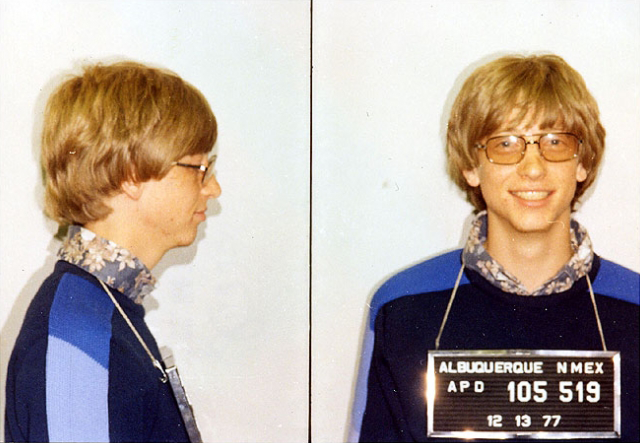
Mugshots of 22 year-old Gates following his 1977 arrest for a traffic violation in Albuquerque, New Mexico
Gates was born in Seattle, Washington on October 28, 1955. He is the son of William H. Gates Sr.[2] (b. 1925) and Mary Maxwell Gates (1929–1994). His ancestry includes English, German, and Irish/Scots-Irish.[20][21] His father was a prominent lawyer, and his mother served on the board of directors for First Interstate BancSystem and the United Way of America. Gates' maternal grandfather was J. W. Maxwell, a national bank president. Gates has an older sister Kristi (Kristianne) and a younger sister Libby. He is the fourth of his name in his family but is known as William Gates III or "Trey" because his father had the "II" suffix.[22][23] The family lived in the Sand Point area of Seattle in a home that was damaged by a rare tornado when Gates was seven years old.[24] Early in his life, Gates observed that his parents wanted him to pursue a law career.[25] When he was young, his family regularly attended a church of the Congregational Christian Churches, a Protestant Reformed denomination.[26][27][28] Gates was small for his age and was bullied as a child. He preferred to stay in his room where he would shout "I'm thinking" when his mother asked what he was doing.[23] The family encouraged competition; one visitor reported that "it didn't matter whether it was hearts or pickleball or swimming to the dock; there was always a reward for winning and there was always a penalty for losing".[29]
At 13, he enrolled in the private Lakeside prep school,[30] and he wrote his first software program.[31] When he was in the eighth grade, the Mothers' Club at the school used proceeds from Lakeside School's rummage sale to buy a Teletype Model 33 ASR terminal and a block of computer time on a General Electric (GE) computer for the students.[32] Gates took an interest in programming the GE system in BASIC, and he was excused from math classes to pursue his interest. He wrote his first computer program on this machine, an implementation of tic-tac-toe which allowed users to play games against the computer. Gates was fascinated by the machine and how it would always execute software code perfectly.[33] After the Mothers Club donation was exhausted, he and other students sought time on systems including DEC PDP minicomputers. One of these systems was a PDP-10 belonging to Computer Center Corporation (CCC) which banned Gates, Paul Allen, Ric Weiland, and Gates' best friend Kent Evans for the summer after it caught them exploiting bugs in the operating system to obtain free computer time.[34][35][23]
The four students had formed the Lakeside Programmers Club to make money.[23] At the end of the ban, they offered to find bugs in CCC's software in exchange for extra computer time. Rather than use the system remotely via Teletype, Gates went to CCC's offices and studied source code for various programs that ran on the system, including Fortran, Lisp, and machine language. The arrangement with CCC continued until 1970, when the company went out of business. The following year, Information Sciences, Inc. hired the four students to write a payroll program in COBOL, providing them computer time and royalties. Gates wrote the school's student information system software to schedule students in classes, and he modified the code so that he was placed in classes with "a disproportionate number of interesting girls."[36]
At 17, Gates formed a venture with Allen called Traf-O-Data to make traffic counters based on the Intel 8008 processor.[37] In 1972, he served as a congressional page in the House of Representatives.[38][39] He was a National Merit Scholar when he graduated from Lakeside School in 1973.[40] He scored 1590 out of 1600 on the Scholastic Aptitude Tests (SAT) and enrolled at Harvard College in the autumn of 1973.[41][42] He chose a pre-law major but took mathematics and graduate level computer science courses.[43] While at Harvard, he met fellow student Steve Ballmer. Gates left Harvard after two years while Ballmer stayed and graduated magna cum laude. Ballmer succeeded Gates as Microsoft's CEO years later and maintained that position from 2000 until his resignation in 2014.[44]
Gates devised an algorithm for pancake sorting as a solution to one of a series of unsolved problems[45] presented in a combinatorics class by professor Harry Lewis. His solution held the record as the fastest version for over 30 years;[45][46] its successor is faster by only one percent.[45] His solution was formalized in a published paper in collaboration with Harvard computer scientist Christos Papadimitriou.[47]
Gates did not have a definite study plan while he was a student at Harvard,[48] and he spent a lot of time using the school's computers. He remained in contact with Paul Allen, and he joined him at Honeywell during the summer of 1974.[49] The MITS Altair 8800 was released the following year based on the Intel 8080 CPU, and Gates and Allen saw this as the opportunity to start their own computer software company.[50] Gates dropped out of Harvard at this time. He had talked over this decision with his parents, who were supportive of him after seeing how much he wanted to start his own company.[48] He explained his decision to leave Harvard: "if things hadn't worked out, I could always go back to school. I was officially on leave."[51]
Microsoft
BASIC
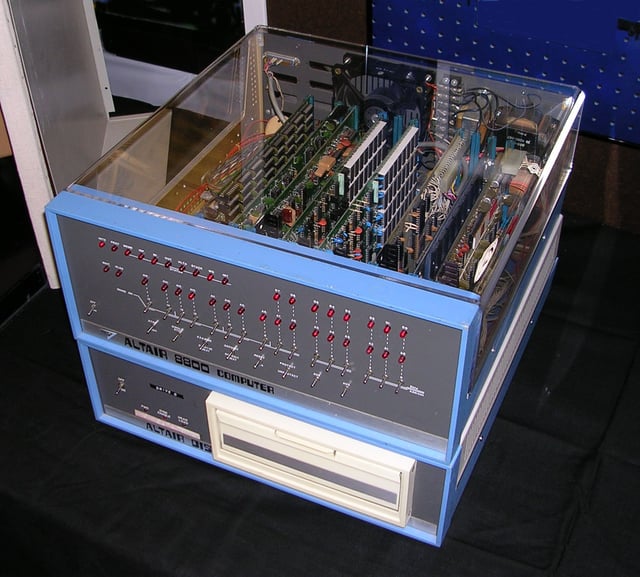
MITS Altair 8800 Computer with 8-inch (200 mm) floppy disk system
Gates read the January 1975 issue of Popular Electronics which demonstrated the Altair 8800, and he contacted Micro Instrumentation and Telemetry Systems (MITS) to inform them that he and others were working on a BASIC interpreter for the platform.[52] In reality, Gates and Allen did not have an Altair and had not written code for it; they merely wanted to gauge MITS's interest. MITS president Ed Roberts agreed to meet them for a demonstration, and over the course of a few weeks they developed an Altair emulator that ran on a minicomputer, and then the BASIC interpreter. The demonstration was held at MITS's offices in Albuquerque, New Mexico; it was a success and resulted in a deal with MITS to distribute the interpreter as Altair BASIC. MITS hired Allen,[53] and Gates took a leave of absence from Harvard to work with him at MITS in November 1975. Allen named their partnership "Micro-Soft", a combination of "microcomputer" and "software", and their first office was in Albuquerque.[53] They dropped the hyphen within a year, and they registered the trade name "Microsoft" on November 26, 1976 with the Secretary of the State of New Mexico.[53] Gates never returned to Harvard to complete his studies.
Microsoft's Altair BASIC was popular with computer hobbyists, but Gates discovered that a pre-market copy had leaked out and was being widely copied and distributed. In February 1976, he wrote an Open Letter to Hobbyists in the MITS newsletter in which he asserted that more than 90 percent of the users of Microsoft Altair BASIC had not paid Microsoft for it and the Altair "hobby market" was in danger of eliminating the incentive for any professional developers to produce, distribute, and maintain high-quality software.[54] This letter was unpopular with many computer hobbyists, but Gates persisted in his belief that software developers should be able to demand payment. Microsoft became independent of MITS in late 1976, and it continued to develop programming language software for various systems.[53] The company moved from Albuquerque to Bellevue, Washington on January 1, 1979.[52]
During Microsoft's early years, all employees had broad responsibility for the company's business. Gates oversaw the business details, but he also continued to write code. He claims that he personally reviewed every line of code that the company produced, and often rewrote parts of it as he saw fit.[55]
IBM partnership
IBM approached Microsoft in July 1980 concerning an operating system for its upcoming IBM PC.[56] IBM first proposed that Microsoft write the BASIC interpreter. IBM's representatives also mentioned that they needed an operating system, and Gates referred them to Digital Research (DRI), makers of the widely used CP/M operating system.[57] IBM's discussions with Digital Research went poorly, however, and they did not reach a licensing agreement. IBM representative Jack Sams mentioned the licensing difficulties during a subsequent meeting with Gates and told him to get an acceptable operating system. A few weeks later, Gates and Allen proposed using 86-DOS (QDOS), an operating system similar to CP/M that Tim Paterson of Seattle Computer Products (SCP) had made for hardware similar to the PC.[58] Microsoft made a deal with SCP to be the exclusive licensing agent of 86-DOS, and later the full owner. They adapted the operating system for the PC and delivered it to IBM as PC DOS for a one-time fee of $50,000.[59]
Gates did not offer to transfer the copyright on the operating system because he believed that other hardware vendors would clone IBM's system.[59] They did, and the sales of MS-DOS made Microsoft a major player in the industry.[60] The press quickly identified Microsoft as being very influential on the new computer, despite IBM's name on it. PC Magazine asked if Gates was "the man behind the machine?",[56] and InfoWorld quoted an expert as stating "it's Gates' computer".[61] Gates oversaw Microsoft's company restructuring on June 25, 1981, which re-incorporated the company in Washington state and made Gates the president and chairman of the board.[52]
Windows
Microsoft launched its first retail version of Microsoft Windows on November 20, 1985. In August of the following year, the company struck a deal with IBM to develop a separate operating system called OS/2. Although the two companies successfully developed the first version of the new system, the partnership deteriorated due to mounting creative differences.[62]
Management style
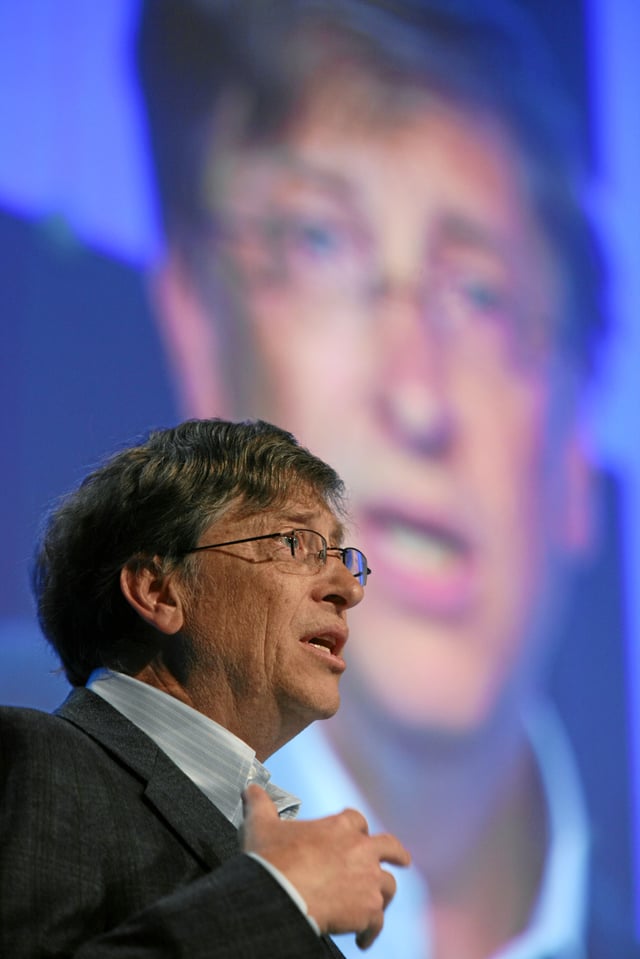
Gates delivers a speech at the World Economic Forum in Switzerland, January 2008
Gates had primary responsibility for Microsoft's product strategy from the company's founding in 1975 until 2006. He gained a reputation for being distant from others; an industry executive complained in 1981 that "Gates is notorious for not being reachable by phone and for not returning phone calls."[63] An Atari executive recalled that he showed Gates a game and defeated him 35 of 37 times. When they met again a month later, Gates "won or tied every game. He had studied the game until he solved it. That is a competitor".[64]
Gates met regularly with Microsoft's senior managers and program managers, and the managers described him as being verbally combative. He also berated them for perceived holes in their business strategies or proposals that placed the company's long-term interests at risk.[65][66] He interrupted presentations with such comments as "that's the stupidest thing I've ever heard"[67] and "why don't you just give up your options and join the Peace Corps?"[68] The target of his outburst would then have to defend the proposal in detail until Gates was fully convinced.[67] When subordinates appeared to be procrastinating, he was known to remark sarcastically, "I'll do it over the weekend."[69][70][71]
During Microsoft's early history, Gates was an active software developer, particularly in the company's programming language products, but his primary role in most of the company's history was as a manager and executive. He has not officially been on a development team since working on the TRS-80 Model 100,[72] but he wrote code that shipped with the company's products as late as 1989.[70] Jerry Pournelle wrote in 1985 when Gates announced Microsoft Excel: "Bill Gates likes the program, not because it's going to make him a lot of money (although I'm sure it will do that), but because it's a neat hack."[73]
On June 15, 2006, Gates announced that he would transition out of his role at Microsoft to dedicate more time to philanthropy. He divided his responsibilities between two successors when he placed Ray Ozzie in charge of management and Craig Mundie in charge of long-term product strategy.[74]
Antitrust litigation
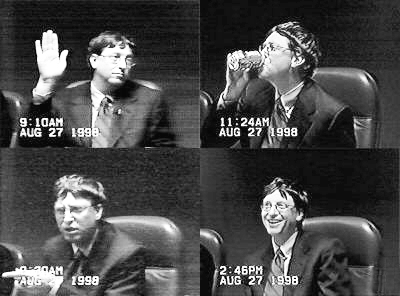
Gates giving his deposition at Microsoft on August 27, 1998
Gates approved of many decisions that led to antitrust litigation over Microsoft's business practices. In the 1998 United States v. Microsoft case, Gates gave deposition testimony which several journalists characterized as evasive. He argued with examiner David Boies over the contextual meaning of words such as "compete", "concerned", and "we". The judge and observers in the courtroom were seen laughing at various points during the deposition.[75] BusinessWeek reported:
Early rounds of his deposition show him offering obfuscatory answers and saying "I don't recall" so many times that even the presiding judge had to chuckle. Worse, many of the technology chief's denials and pleas of ignorance were directly refuted by prosecutors with snippets of e-mail that Gates both sent and received.[76]
Gates later said that he had simply resisted attempts by Boies to mischaracterize his words and actions. "Did I fence with Boies? … I plead guilty… rudeness to Boies in the first degree."[77] Despite Gates' denials, the judge ruled that Microsoft had committed monopolization and tying, and blocking competition, both in violation of the Sherman Antitrust Act.[77]
Post-Microsoft
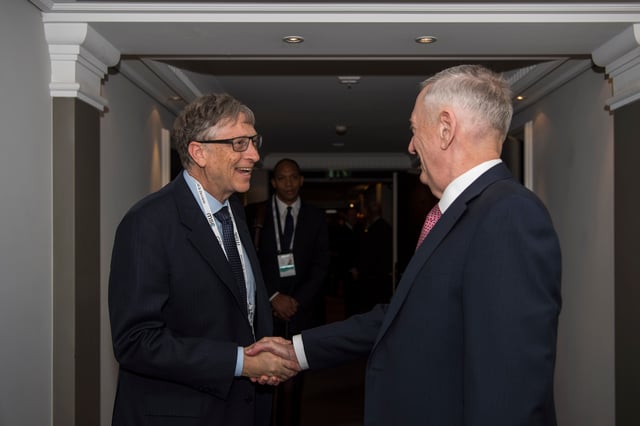
Gates meets with U.S. Secretary of Defense James Mattis, February 2017
Since leaving day-to-day operations at Microsoft, Gates has continued his philanthropy and works on other projects.
According to the Bloomberg Billionaires Index, Gates was the world's highest-earning billionaire in 2013, as his net worth increased by US$15.8 billion to US$78.5 billion. As of January 2014, most of Gates' assets are held in Cascade Investment LLC, an entity through which he owns stakes in numerous businesses, including Four Seasons Hotels and Resorts, and Corbis Corp.[78] On February 4, 2014, Gates stepped down as chairman of Microsoft to become Technology Advisor alongside new CEO Satya Nadella.[12][79]
Gates provided his perspective on a range of issues in a substantial interview that was published in the March 27, 2014 issue of Rolling Stone magazine. In the interview, Gates provided his perspective on climate change, his charitable activities, various tech companies and people involved in them, and the state of America. In response to a question about his greatest fear when he looks 50 years into the future, Gates stated: "... there'll be some really bad things that'll happen in the next 50 or 100 years, but hopefully none of them on the scale of, say, a million people that you didn't expect to die from a pandemic, or nuclear or bioterrorism." Gates also identified innovation as the "real driver of progress" and pronounced that "America's way better today than it's ever been."[80]
Gates has expressed concern about the potential harms of superintelligence; in a Reddit "ask me anything", he stated that
First the machines will do a lot of jobs for us and not be super intelligent. That should be positive if we manage it well. A few decades after that though the intelligence is strong enough to be a concern. I agree with Elon Musk and some others on this and don't understand why some people are not concerned.[81][82][83][84]
In a March 2015 interview, with Baidu's CEO, Robin Li, Gates claimed he would "highly recommend" Nick Bostrom's recent work, Superintelligence: Paths, Dangers, Strategies.[85]
In March 2018, Gates met at his home in Seattle with Mohammed bin Salman, the reformist crown prince and de facto ruler of Saudi Arabia to discuss investment opportunities for Saudi Vision 2030.[86][87]
In an interview on stage in 2019, Gates admitted that losing the mobile OS space to Android was his biggest mistake. He stated that it was within their skillset of being the dominant mobile operating system, but the company was distracted during that period because of the ongoing anti-trust litigation.[88]
In 2019, Bill Gates became an Advisory Board Member of the Bloomberg New Economy Forum.[89]
Philanthropy
Bill and Melinda Gates Foundation
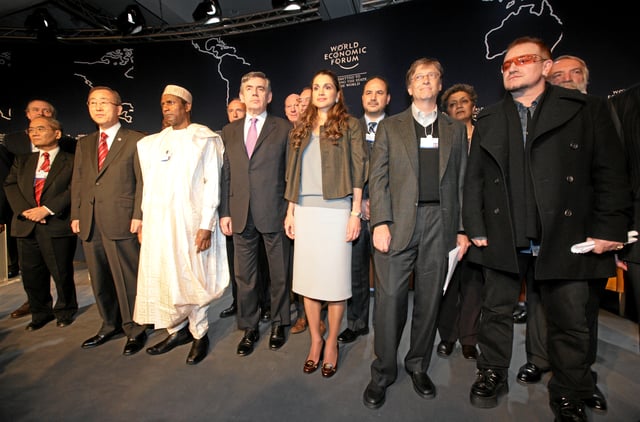
Gates with Bono, Queen Rania of Jordan, former British Prime Minister Gordon Brown, President Umaru Yar'Adua of Nigeria and others during the Annual Meeting 2008 of the World Economic Forum
Gates studied the work of Andrew Carnegie and John D. Rockefeller, and donated some of his Microsoft stock in 1994 to create the "William H. Gates Foundation." In 2000, Gates and his wife combined three family foundations and Gates donated stock valued at $5 billion to create the charitable Bill & Melinda Gates Foundation, which was identified by the Funds for NGOs company in 2013, as the world's wealthiest charitable foundation, with assets reportedly valued at more than $34.6 billion.[90][91] The Foundation allows benefactors to access information that shows how its money is being spent, unlike other major charitable organizations such as the Wellcome Trust.[92][93] Gates, through his foundation, also donated $20 million to Carnegie Mellon University for a new building to be named Gates Center for Computer Science which opened in 2009.[94][95]
Gates has credited the generosity and extensive philanthropy of David Rockefeller as a major influence. Gates and his father met with Rockefeller several times, and their charity work is partly modeled on the Rockefeller family's philanthropic focus, whereby they are interested in tackling the global problems that are ignored by governments and other organizations.[96] As of 2007, Bill and Melinda Gates were the second-most generous philanthropists in America, having given over $28 billion to charity;[97] the couple plan to eventually donate 95 percent of their wealth to charity.[98]
The foundation is organized into four program areas: Global Development Division, Global Health Division, United States Division, and Global Policy & Advocacy Division.[99] The foundation supports the use of genetically modified organisms in agricultural development. Specifically, the foundation is supporting the International Rice Research Institute in developing Golden Rice, a genetically modified rice variant used to combat vitamin A deficiency.[100]
Personal donations
Melinda Gates suggested that people should emulate the philanthropic efforts of the Salwen family, who sold their home and gave away half of its value, as detailed in their book, The Power of Half.[101] Gates and his wife invited Joan Salwen to Seattle to speak about what the family had done, and on December 9, 2010, Bill and Melinda Gates and investor Warren Buffett each signed a commitment they called the "Giving Pledge", which is a commitment by all three to donate at least half of their wealth, over the course of time, to charity.[102][103][104]
Gates has also provided personal donations to educational institutions. In 1999, Gates donated $20 million to the Massachusetts Institute of Technology for the construction of a computer laboratory named the "William H. Gates Building" that was designed by architect Frank Gehry. While Microsoft had previously given financial support to the institution, this was the first personal donation received from Gates.[105]
The Maxwell Dworkin Laboratory of the Harvard John A. Paulson School of Engineering and Applied Sciences is named after the mothers of both Gates and Microsoft President Steven A. Ballmer, both of whom were students (Ballmer was a member of the School's graduating class of 1977, while Gates left his studies for Microsoft), and donated funds for the laboratory's construction.[106] Gates also donated $6 million to the construction of the Gates Computer Science Building, completed in January 1996, on the campus of Stanford University. The building contains the Computer Science Department and the Computer Systems Laboratory (CSL) of Stanford's Engineering department.[107]
On August 15, 2014, Bill Gates posted a video of himself on Facebook in which he is seen performing the Ice Bucket Challenge. Gates posted the video after Facebook founder Mark Zuckerberg challenged him to do so in order to raise awareness for amyotrophic lateral sclerosis.[108]
Since about 2005, Bill Gates and his foundation have taken an interest in solving global sanitation problems. For example, they announced the "Reinvent the Toilet Challenge", which has received considerable media interest.[109] To raise awareness for the topic of sanitation and possible solutions, Gates drank water that was "produced from human feces" in 2014 – in fact it was produced from a sewage sludge treatment process called the Omni Processor.[110][111] In early 2015, he also appeared with Jimmy Fallon on The Tonight Show and challenged him to see if he could taste the difference between this reclaimed water or bottled water.[112]
In November 2017, Gates said he would give $50 million to the Dementia Discovery Fund, a venture capital that seeks treatment for Alzheimer's disease. He also pledged an additional $50 million to start-up ventures working in Alzheimer's research.[113]
Bill and Melinda Gates have said that they intend to leave their three children $10 million each as their inheritance. With only $30 million kept in the family, they appear to be on a course to give away about 99.96 percent of their wealth.[114] On August 25, 2018, Gates distributed $600,000 through his Melinda and Gates Foundation via UNICEF which is helping flood affected victims in Kerala, India.[115]
Criticism
In 2007, the Los Angeles Times criticized the foundation for investing its assets in companies that have been accused of worsening poverty, polluting heavily, and pharmaceutical companies that do not sell to developing countries.[116] In response to press criticism, the foundation announced a review of its investments to assess social responsibility.[117] It subsequently canceled the review and stood by its policy of investing for maximum return, while using voting rights to influence company practices.[118] The Gates Millennium Scholars Program, which was established to provide academic scholarships for high-achieving ethnic minority students, was criticized by Republican Ernest W. Lefever for its exclusion of white students.[119] The scholarship program is administered by the United Negro College Fund.[120] In 2014, Bill Gates sparked a protest in Vancouver when he decided to donate $50 million to UNAIDS through the Bill & Melinda Gates Foundation for the purpose of mass circumcision in Zambia and Swaziland.[121][122]
Charity sports events
On April 29, 2017, Bill Gates partnered with Swiss tennis legend Roger Federer in play in the Match for Africa 4, a noncompetitive tennis match at a sold-out Key Arena in Seattle. The event was in support of Roger Federer Foundation's charity efforts in Africa.[123] Federer and Gates played against John Isner, the top-ranked American player for much of this decade, and Mike McCready, the lead guitarist for Pearl Jam. Gates and Federer won the match 6 to 4. Overall, they raised $2 million for children in Africa.[124] The following year, Gates and Federer returned to play in the Match for Africa 5 on March 5, 2018, at San Jose's SAP Center. Their opponents were Jack Sock, one of the top American players and a grand slam winner in doubles, and Savannah Guthrie, a co-anchor for NBC's Today show. Gates and Federer recorded their second match victory together by a score of 6–3 and the event raised over $2.5 million.[125]
Recognition
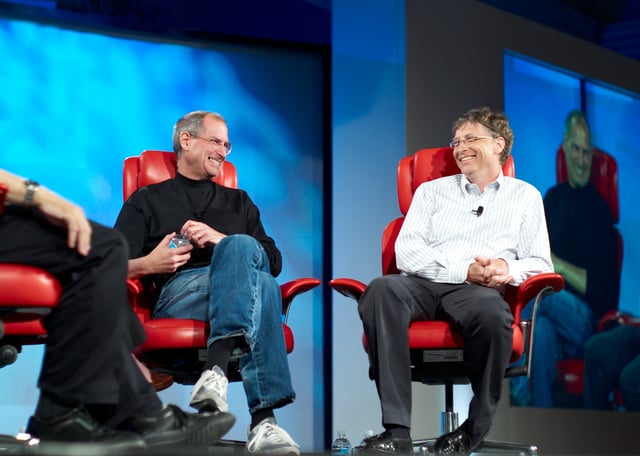
Steve Jobs and Gates at D: All Things Digital in 2007
In 1987, Gates was listed as a billionaire in Forbes magazine's 400 Richest People in America issue. He was worth $1.25 billion and was the world's youngest self-made billionaire.[15] Since 1987, Gates has been included in the Forbes The World's Billionaires list and was the wealthiest from 1995 to 1996,[126] 1998 to 2007, 2009, and has been since 2014.[3] Gates was number one on the Forbes 400 list from 1993 through to 2007, 2009, and 2014 through 2017.[127][128]
Time magazine named Gates one of the 100 people who most influenced the 20th century, as well as one of the 100 most influential people of 2004, 2005, and 2006.
Time also collectively named Gates, his wife Melinda and U2's lead singer Bono as the 2005 Persons of the Year for their humanitarian efforts.[129] In 2006, he was voted eighth in the list of "Heroes of our time".[130]
Gates was listed in the Sunday Times power list in 1999, named CEO of the year by Chief Executive Officers magazine in 1994, ranked number one in the "Top 50 Cyber Elite" by Time in 1998, ranked number two in the Upside Elite 100 in 1999, and was included in The Guardian as one of the "Top 100 influential people in media" in 2001.[131]
Gates was elected a member of the US National Academy of Engineering in 1996 "for contributions to the founding and development of personal computing".[132]
He was named Honorary Member of the American Library Association in 1998.[133]
He was elected a foreign member of the Chinese Academy of Engineering in 2017.[134]
According to Forbes, Gates was ranked as the fourth most powerful person in the world in 2012,[135] up from fifth in 2011.[136]
In 1994, he was honored as the 20th Distinguished Fellow of the British Computer Society. In 1999, Gates received New York Institute of Technology's President's Medal.[137]
Gates has received honorary doctorates from Nyenrode Business Universiteit,[138] KTH Royal Institute of Technology,[139] Waseda University, Tsinghua University,[140] Harvard University,[141] the Karolinska Institute,[142] and Cambridge University.[143]
He was also made an honorary trustee of Peking University in 2007.[144]
Gates was made an Honorary Knight Commander of the Order of the British Empire by Queen Elizabeth II in 2005.[145]
In November 2006, he was awarded the Placard of the Order of the Aztec Eagle, together with his wife Melinda who was awarded the Insignia of the same order, both for their philanthropic work around the world in the areas of health and education, particularly in Mexico, and specifically in the program "Un país de lectores".[146]
Gates received the 2010 Bower Award for Business Leadership from The Franklin Institute for his achievements at Microsoft and his philanthropic work.[147]
Also in 2010, he was honored with the Silver Buffalo Award by the Boy Scouts of America, its highest award for adults, for his service to youth.[148]
In 2002, Bill and Melinda Gates received the Jefferson Award for Greatest Public Service Benefiting the Disadvantaged.[149]
He was given the 2006 James C. Morgan Global Humanitarian Award from the Tech Awards.[150]
In 2015 Gates, along with his wife Melinda, received the Padma Bhushan, India's third-highest civilian award for their social work in the country.[151][152]
Barack Obama honored Bill and Melinda Gates with the Presidential Medal of Freedom for their philanthropic efforts in 2016,[153] and François Hollande awarded Bill and Melinda in the following year with France's highest national award – the Legion of Honour for their charity efforts.[154]
Entomologists named Bill Gates' flower fly, Eristalis gatesi, in his honor in 1997.[155]
Personal life
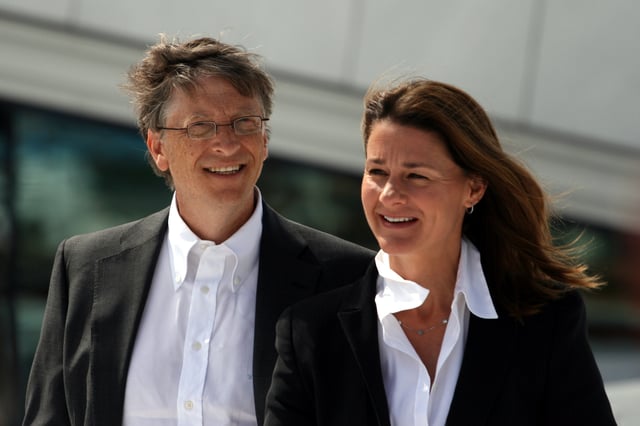
Gates and his wife, Melinda, 2009
Gates married Melinda French on a golf course on the Hawaiian island of Lanai on January 1, 1994. They have three children. The family resides in Xanadu 2.0, an earth-sheltered mansion in the side of a hill overlooking Lake Washington in Medina, Washington. According to 2007 King County public records, the total assessed value of the property—land and house—is US$125 million, and the annual property taxes are US$991,000. The 66,000-square-foot (6,100 m2) estate has a 60-foot (18 m) swimming pool with an underwater music system, as well as a 2,500-square-foot (230 m2) gym and a 1,000-square-foot (93 m2) dining room.[156]
In an interview with Rolling Stone, Gates stated in regard to his faith: "The moral systems of religion, I think, are super important. We've raised our kids in a religious way; they've gone to the Catholic church that Melinda goes to and I participate in. I've been very lucky, and therefore I owe it to try and reduce the inequity in the world. And that's kind of a religious belief. I mean, it's at least a moral belief."[157]
In the same interview, Gates said: "I agree with people like Richard Dawkins that mankind felt the need for creation myths. Before we really began to understand disease and the weather and things like that, we sought false explanations for them. Now science has filled in some of the realm – not all – that religion used to fill. But the mystery and the beauty of the world is overwhelmingly amazing, and there's no scientific explanation of how it came about. To say that it was generated by random numbers, that does seem, you know, sort of an uncharitable view [laughs]. I think it makes sense to believe in God, but exactly what decision in your life you make differently because of it, I don't know."[157]
Gates purchased the Codex Leicester, a collection of scientific writings by Leonardo da Vinci, for US$30.8 million at an auction in 1994.[158] Gates is an avid reader, and the ceiling of his large home library is engraved with a quotation from The Great Gatsby.[159] He also enjoys playing bridge, tennis, and golf.[160][161]
In 1999, his wealth briefly surpassed US$101 billion.[162] Despite his wealth and extensive business travel, Gates usually flew coach in commercial aircraft until 1997, when he bought a private jet.[163] Since 2000, the nominal value of his Microsoft holdings has declined due to a fall in Microsoft's stock price after the dot-com bubble burst and the multibillion-dollar donations he has made to his charitable foundations. In a May 2006 interview, Gates commented that he wished that he were not the richest man in the world because he disliked the attention it brought.[164] In March 2010, Gates was the second wealthiest person behind Carlos Slim, but regained the top position in 2013, according to the Bloomberg Billionaires List.[165][166] Slim retook the position again in June 2014[167][168] (but then lost the top position back to Gates). Between 2009 and 2014, his wealth doubled from US$40 billion to more than US$82 billion.[169] Since October 2017, Gates was surpassed by Amazon.com founder Jeff Bezos as the richest person in the world.[16]
Gates has held the top spot on the list of The World's Billionaires for 18 out of the past 23 years.[170] Gates has several investments outside Microsoft, which in 2006 paid him a salary of US$616,667 and US$350,000 bonus totalling US$966,667.[171] In 1989, he founded Corbis, a digital imaging company. In 2004, he became a director of Berkshire Hathaway, the investment company headed by long-time friend Warren Buffett.[172] In 2016, he was discussing his gaming habits when he revealed that he was color-blind.[173]
In a BBC interview, Gates claimed, "I've paid more tax than any individual ever, and gladly so ... I've paid over $6 billion in taxes."[174] He is a proponent of higher taxes, particularly for the rich.[175] Gates' days are planned for him on a minute-by-minute basis, similar to the U.S. President's schedule.[176]
External business ventures and investments
Cascade Investment LLC, a private investment and holding company incorporated in the United States, controlled by Bill Gates and headquartered in Kirkland, Washington.
bgC3, a new think-tank company founded by Gates.
Corbis, a digital image licensing and rights services company.
TerraPower, a nuclear reactor design company.
Eclipse Aviation, a defunct manufacturer of very light jets. Gates was a major stake-holder early on in the project.
ResearchGate, a social networking site for scientists. Gates participated in a $35 million round of financing along with other investors.[177]
In media
Books
Gates has written two books:
The Road Ahead, written with Microsoft executive Nathan Myhrvold and journalist Peter Rinearson, was published in November 1995. It summarized the implications of the personal computing revolution and described a future profoundly changed by the arrival of a global information superhighway.
Business @ the Speed of Thought was published in 1999, and discusses how business and technology are integrated, and shows how digital infrastructures and information networks can help getting an edge on the competition.
Documentaries
The Machine That Changed the World (1990)
Triumph of the Nerds (1996)
Nerds 2.0.1 (1998)
Waiting for "Superman" (2010)[179]
The Virtual Revolution (2010)
Inside Bill's Brain: Decoding Bill Gates (2019)
Feature films
1999: Pirates of Silicon Valley, a film which chronicles the rise of Apple and Microsoft from the early 1970s to 1997. Gates is portrayed by Anthony Michael Hall.
2002: Nothing So Strange, a mocumentary featuring Gates as the subject of a modern assassination. Gates briefly appears at the start, played by Steve Sires.
2010: The Social Network, a film which chronicles the development of Facebook. Gates is portrayed by Steve Sires.[180]
2015: Steve Jobs vs. Bill Gates: The Competition to Control the Personal Computer, 1974–1999: Original film from the National Geographic Channel for the American Genius series.[181]
Video and film clips
1983: Steve Jobs hosts Bill Gates in the Macintosh dating game at the Macintosh pre-launch event (with Steve Jobs and Mitch Kapor, references the television show, The Dating Game)
2007: Steve Jobs and Bill Gates Together at D5 Conference [199]
Radio
Gates was the guest on BBC Radio 4's Desert Island Discs on January 31, 2016, in which he talks about his relationships with his father and Steve Jobs, meeting Melinda Ann French, the start of Microsoft and some of his habits (for example reading The Economist "from cover to cover every week"). His choice of things to take on a desert island were, for music: "Blue Skies" by Willie Nelson; book: The Better Angels of Our Nature by Steven Pinker; and luxury item: a DVD Collection of Lectures from The Teaching Company.[182]
Television
Gates made a guest appearance as himself on the Emmy Award winning TV show, The Big Bang Theory. The episode on which he appeared was appropriately entitled, "The Gates Excitation."[183]
See also
Big History Project
List of richest Americans in history
List of wealthiest historical figures



